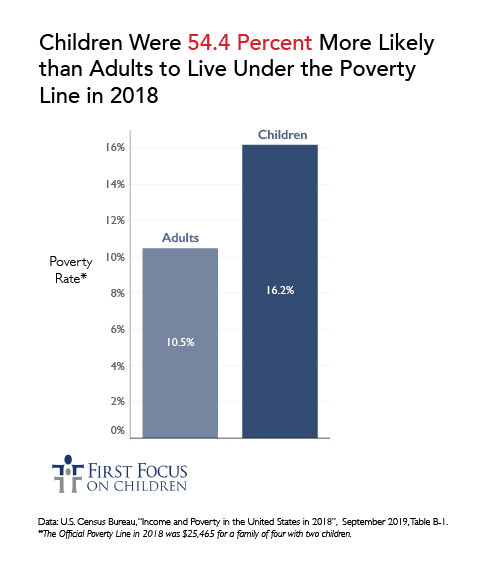Today, the U.S. Census Bureau released its annual national data on poverty in America and it paints the picture that we know all too well: Our child poverty rate remains stubbornly high despite the fact that we have the solutions to address it.
The Numbers
According to the Census Bureau’s Official Poverty Measure (OPM), 16.2 percent of children (11.9 million) were living in poverty in 2018. (The official poverty line for a family of four with two children is $25,465 a year.)
The new figure represents a 1.2 percent decrease from 2017. While we are encouraged to see this small decrease in the child poverty rate, we know that children still have a 54.4 percent higher chance of living in poverty than adults and that the United States continues to have a significantly higher rate of child poverty than most of our peer countries.

And due to the continual racism and discrimination ingrained in our country’s institutions, children of color continue to experience rates of poverty three times that of white children. 29.5 percent of Black children and 23.7 percent of Hispanic children were living in poverty in 2018 compared to 8.9 percent of white children.
The figures also show a modest decrease in children living in deep poverty, with 6.9 percent of children living in deep poverty in 2018 ($12,732 a year for a family of four with two children). This number remains particularly worrisome, since households living in deep poverty lack the income to meet their children’s basic needs.
Despite the vulnerability of children living in households of deep poverty, they often lack access to assistance. Many anti-poverty programs are contingent on a household having some income, yet families in deep poverty have little to no earnings due to barriers such as disability, substance abuse, mental health or other complex and persistent issues that prevent them from working full time or at all.
The good news is that we are making more progress than the OPM indicates. The Supplemental Poverty Measure, also released today, tells us that when we take anti-poverty programs such as the Earned Income Tax Credit (EITC), Child Tax Credit (CTC), the Supplemental Nutrition Assistance Program (SNAP), housing assistance and other programs into account (as well as other factors) the child poverty rate drops to 13.7 percent.
We Know How To End Child Poverty
However, no matter what measure you use to indicate child poverty in the United States, our rate remains high – an inexcusable trend considering that findings of a landmark study released earlier this year from the nonpartisan National Academy of Sciences show that we know how to make progress. A Roadmap to Reducing Child Povertyputs forward a set of policy and program changes that, if implemented, would cut our national child poverty rate in half within a decade. While the study committee finds that no single policy can cut our child poverty rate in half within a decade, establishing a $3,000 annual child allowance would have the biggest impact by far and would cut our deep child poverty rate in half within a decade. Structural improvements and funding increases to the EITC, SNAP and housing vouchers would also make a serious dent.
The study committee also finds that implementing these changes are cost-effective. Poverty costs our country upwards of $1 trillion a year due to reduced economic activity and output, yet cutting our child poverty rate in half within a decade would cost less than $110 billion a year.
Yet our country is going in the opposite direction. Today First Focus on Children released our annual Children’s Budget Book, which reports that the share of spending on children in the United States declined to an all-time low of just 7.21% in FY2019.
And recently, we have also seen a slew of harmful regulations from the Trump Administration that if implemented, would further increase our child poverty rate by restricting access to critical resources for millions of children.
For this reason, First Focus on Children, with our partners at the U.S. Child Poverty Action Group, launched the End Child Poverty campaign earlier this year and is calling upon the United States to establish a national target to cut our child poverty rate in half within a decade. Setting a target would provide advocates, the media and other stakeholders with a tool to hold our lawmakers accountable for reducing child poverty. We have seen evidence of the effectiveness of targets in the United Kingdom, Canada and New Zealand as well as here in the United States. Bicameral legislation introduced in past sessions of Congress established a target and we hope to see this legislation reintroduced soon.
Please join us in this effort! You can start by participating in our upcoming Twitterstorm on Tuesday, September 24th at 2pm EST using the hashtag #EndChildPoverty. Please also attend our webinar on Wednesday, September 25th at 3pm EST. For additional details, sign-up for our listserv here and follow us on Twitter at @CPAG_USA.
For more information:
End Child Poverty Press Statement
